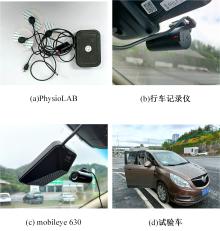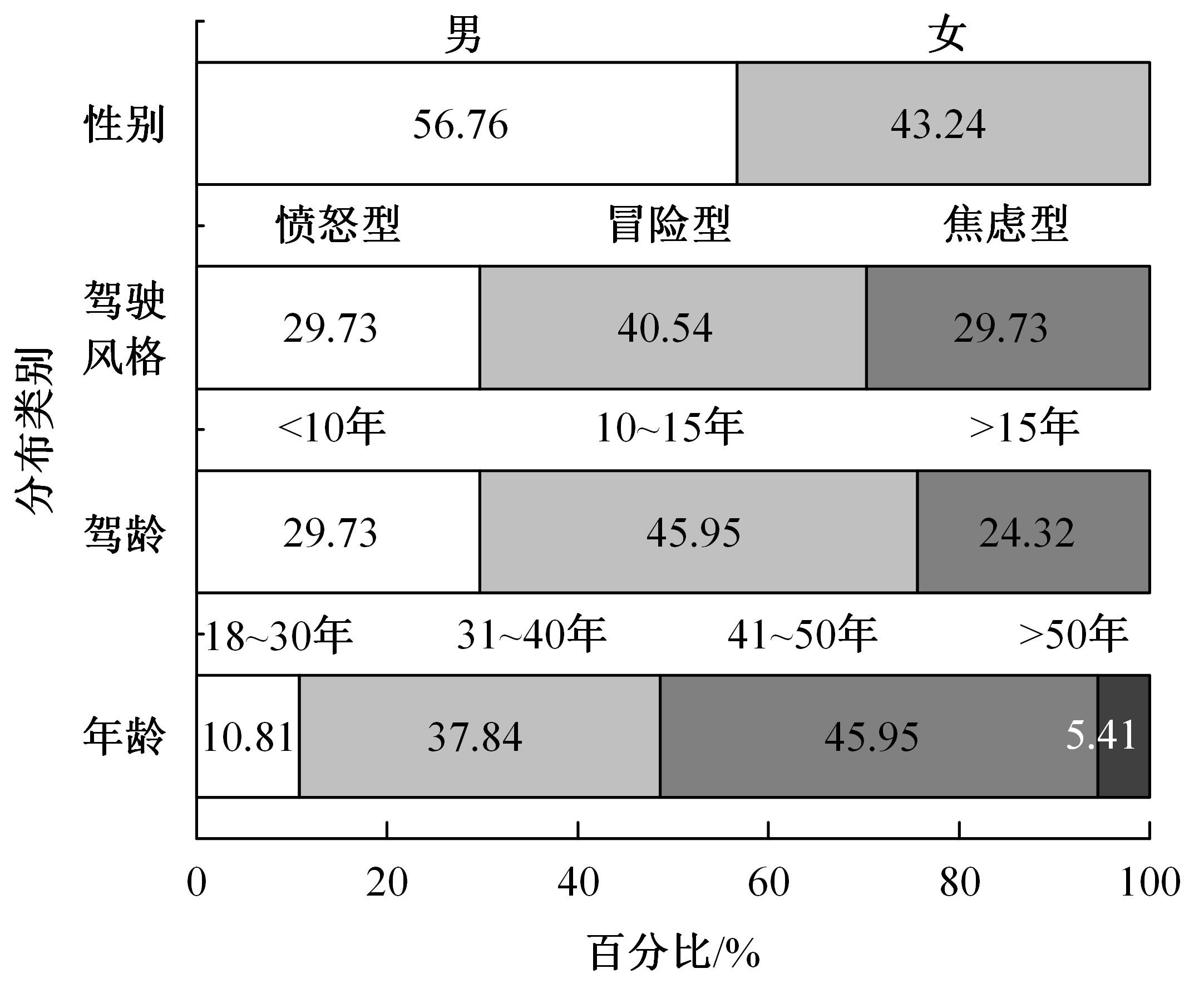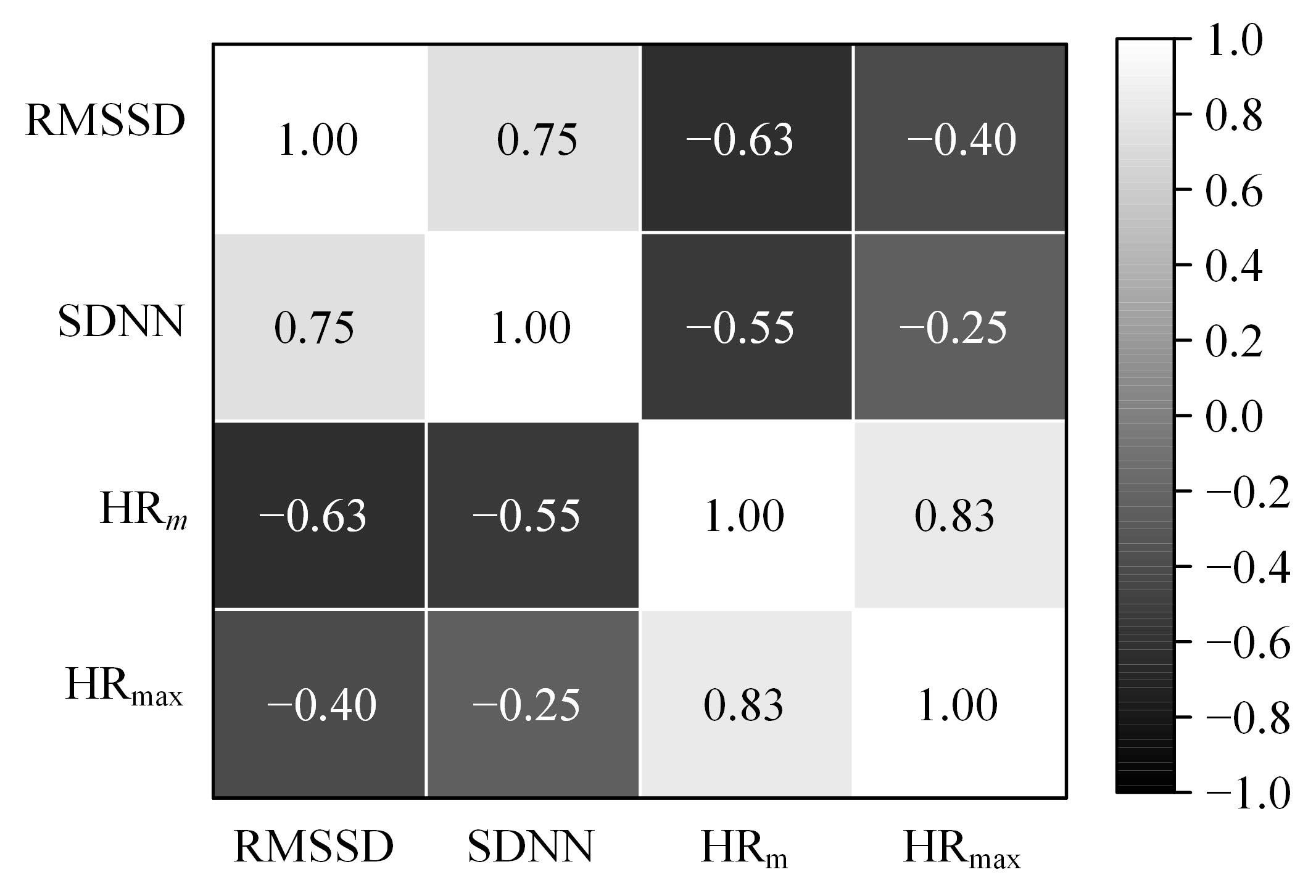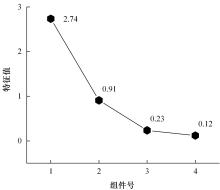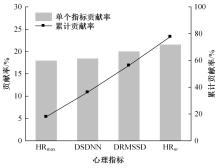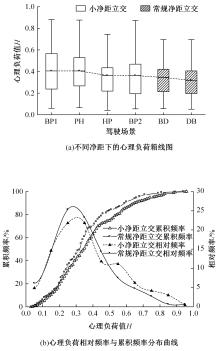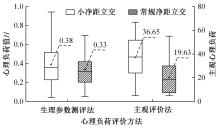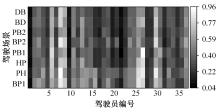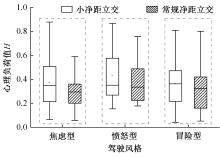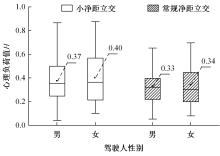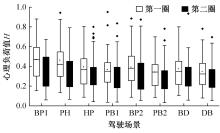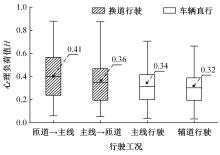吉林大学学报(工学版) ›› 2024, Vol. 54 ›› Issue (10): 2807-2818.doi: 10.13229/j.cnki.jdxbgxb.20221522
• 交通运输工程·土木工程 • 上一篇
基于心电数据的高速公路高密度互通立交驾驶负荷
- 1.重庆交通大学 交通运输学院 重庆 400074
2.重庆交通大学 山区复杂道路环境“人-车-路”协同与安全重庆市重点实验室 重庆 400074
3.重庆城市交通开发投资(集团)有限公司,重庆 401121
Mental workload of drivers at high-density interchanges of freeways based on ECG data
Jin XU1,2( ),Zheng-huan CHEN1,Qi-shuo LIAO3,Zhan-ji ZHENG1,He-shan ZHANG1
),Zheng-huan CHEN1,Qi-shuo LIAO3,Zhan-ji ZHENG1,He-shan ZHANG1
- 1.School of Traffic & Transportation,Chongqing Jiaotong University,Chongqing 400074,China
2.Chongqing Key Laboratory of "Human-Vehicle-Road" Cooperation and Safety for Mountain Complex Environment,Chongqing Jiaotong University,Chongqing 400074,China
3.Chongqing City Transportation Development & Investment Group Co. ,Ltd. ,Chongqing 401121,China
摘要:
为了明确高密度互通立交行驶环境对驾驶负荷的影响,本文在G50沪渝高速公路重庆段一处高密度立交群开展了38名被试的小客车实车驾驶试验,使用PhysioLAB生理仪采集了驾驶人在自然行驶状态下的心电数据。基于心率和心率变异性指标,采用因子分析法构建了心理负荷量化模型,分析了不同立交净距条件下驾驶人的心理负荷差异及其影响因素。结果表明:立交净距的缩小会导致驾驶人心理负荷增加,驾驶人在小净距立交的平均心理负荷比常规净距立交增加了15.15%;不同驾驶风格、不同性别驾驶人之间的心理负荷均存在差异,立交净距的缩小对焦虑型驾驶人和女性驾驶人的影响更大;驾驶人心理负荷随着对行驶环境熟悉度的增加而减小;车辆交织会导致驾驶人心理负荷显著增加,驾驶人在小净距立交合流过程中的平均心理负荷比分流过程增加了13.89%。
中图分类号:
- U491.2
| 1 | 吕能超, 旷权, 吴萌. 基于HRV量化的高速公路出口匝道区域驾驶负荷特性研究[J]. 安全与环境学报, 2015, 15(4): 143-148. |
| Neng-chao Lyu, Kuang Quan, Wu Meng. Study on the specific driving workload features of highway off-ramp area based on the HRV index quantization[J]. Journal of Safety and Environment, 2015, 15(4): 143-148. | |
| 2 | 孙雨斐. 高速公路互通式立交路段对驾驶员工作负荷的影响研究[D]. 西安: 长安大学公路学院, 2021. |
| Sun Yu-fei. Study on the impact of freeway interchange sections on driving workload[D]. Xi'an: School of Highway, Chang'an University, 2021. | |
| 3 | Hu J B, He L C, Wang R H. Safety evaluation of freeway interchange merging areas based on driver workload theory[J]. Science Progress, 2020, 103(3): 1-16. |
| 4 | Hu J B, Wang R H. Classification of driving workload affected by highway alignment conditions based on classification and regression tree algorithm[J]. Traffic Injury Prevention, 2018, 19(2): 214-218. |
| 5 | Shakouri M, Ikuma L H, Aghazadeh F, et al. Analysis of the sensitivity of heart rate variability and subjective workload measures in a driving simulator: the case of highway work zones[J]. International Journal of Industrial Ergonomics, 2018, 66: 136-145. |
| 6 | 乔建刚, 杨程, 陈彦欣. 基于驾驶员心率和速度差的高速公路纵坡度研究[J]. 中国安全生产科学技术, 2022,18(5): 216-221. |
| Qiao Jian-gang, Yang Cheng, Chen Yan-xin. Research on longitudinal slope of expressway based on driver's heart rate and speed difference[J]. Journal of Safety Science and Technology, 2022, 18(5): 216-221. | |
| 7 | Di Flumeri G, Borghini G, Aricò P, et al. EEG-based mental workload neurometric to evaluate the impact of different traffic and road conditions in real driving settings[J]. Frontiers in Human Neuroscience, 2018, 12: 509. |
| 8 | Deng T M, Fu J H, Shao Y M, et al. Pedal operation characteristics and driving workload on slopes of mountainous road based on naturalistic driving tests[J]. Safety Science, 2019, 119: 40-49. |
| 9 | 徐进, 陈薇, 周佳, 等. 汽车转向盘操作与驾驶负荷的相关性[J]. 吉林大学学报:工学版, 2017, 47(2): 438-445. |
| Xu Jin, Chen Wei, Zhou Jia, et al. Correlation between steering and driver's workload[J]. Journal of Jilin University(Engineering and Technology Edition), 2017, 47(2): 438-445. | |
| 10 | 朱可宁, 龚波. 高速公路特长隧道出口段驾驶人心理负荷变化规律[J]. 交通科技与经济, 2017, 19(3): 6-9. |
| Zhu Ke-ning, Gong Bo. Research on driver mental load in exit of super long tunnel[J]. Technology & Economy in Areas of Communications, 2017, 19(3): 6-9. | |
| 11 | 朱彤, 吴玲, 胡月琦, 等. 基于因子模型的高速公路特长隧道驾驶人心理负荷特性研究[J]. 中国公路学报, 2018, 31(11): 165-175. |
| Zhu Tong, Wu Ling, Hu Yue-qi, et al. Research on characteristics of drivers mental workload in extra-long expressway tunnels based on the factor model[J]. China Journal of Highway Transport, 2018, 31(11): 165-175. | |
| 12 | 郭玉洁, 郭唐仪, 吴军. 基于因子分析的城市隧道驾驶人心理负荷变化规律[J]. 交通运输研究, 2021, 7(2): 91-99. |
| Guo Yu-jie, Guo Tang-yi, Wu Jun. Change regularity of drivers' psychological load in urban tunnels based on factor analysis[J]. Transport Research, 2021, 7(2): 91-99. | |
| 13 | 乔建刚, 谢一丹. 基于心生理反应的高速公路隧道入口安全[J]. 科学技术与工程, 2021, 21(23): 10074-10079. |
| Qiao Jian-gang, Xie Yi-dan. Safety of expressway tunnel entrance based on psychophysiological response[J]. Science Technology and Engineering, 2021, 21(23): 10074-10079. | |
| 14 | Feng Z X, Yang M M, Zhang W H, et al. Effect of longitudinal slope of urban underpass tunnels on drivers' heart rate and speed: a study based on a real vehicle experiment[J]. Tunnelling and Underground Space Technology, 2018, 81: 525-533. |
| 15 | 徐进, 孙子秋, 王思棋, 等. 高密度互通立交出口匝道驾驶人视觉搜索行为特征[J]. 东南大学学报:自然科学版, 2022, 52(6): 1189-1198. |
| Xu Jin, Sun Zi-qiu, Wang Si-qi, et al. Characteristics of driver's visual search behavior in exit ramp of high-density interchanges[J]. Journal of Southeast University(Natural Science Edition), 2022, 52(6): 1189-1198. | |
| 16 | 孙龙, 杨程程, 常若松. 多维度驾驶风格量表的修订及初步应用[J]. 人类工效学, 2014, 20(2): 6-9. |
| Sun Long, Yang Cheng-cheng, Chang Ruo-song. Revision and pre-liminary application of multidimensional driving style inventory[J]. Chinese Journal of Ergonomics, 2014, 20(2): 6-9. | |
| 17 | 王海玮, 温惠英, 刘敏. 夜间环境驾驶员精神负荷的生理特性评估与实验[J]. 吉林大学学报:工学版, 2017, 47(2): 420-428. |
| Wang Hai-wei, Wen Hui-ying, Liu Min. Experimental evaluation of nighttime driver's physiological characteristics in driving simulator[J]. Journal of Jilin University(Engineering and Technology Edition), 2017, 47(2): 420-428. | |
| 18 | Fallahi M, Motamedzade M, Heidarimoghadam R, et al. Effects of mental workload on physiological and subjective responses during traffic density monitoring: a field study[J]. Applied Ergonomics, 2016, 52: 95-103. |
| 19 | Feng D S, Chen F, Pan X D. Research on driver physiological load at the lowest point of city river-crossing tunnels[J]. Transportation Research Procedia, 2017, 25: 1494-1502. |
| 20 | Dey A, Mann D D. Sensitivity and diagnosticity of NASA-TLX and simplified SWAT to assess the mental workload associated with operating an agricultural sprayer[J]. Ergonomics, 2010, 53(7): 848-857. |
| [1] | 崔亚宁,司春棣,凡涛涛,王飞. 水-荷耦合作用下沥青桥面铺装层裂缝扩展分析[J]. 吉林大学学报(工学版), 2024, 54(7): 1988-1996. |
| [2] | 高英力,谷小磊,廖美捷,胡新浪,谢雨彤. SiO2气凝胶/反应性弹性体三元共聚物/多聚磷酸复合改性沥青流变性能与改性机理[J]. 吉林大学学报(工学版), 2024, 54(7): 1978-1987. |
| [3] | 何永明,权聪,魏堃,冯佳,万亚楠,陈世升. 超高速公路车路协同路侧单元感知融合方法[J]. 吉林大学学报(工学版), 2024, 54(7): 1923-1934. |
| [4] | 孙雅珍,薛博欣,孙岩,王志臣,潘嘉伟. 考虑非均匀性的沥青混合料开裂行为细观模拟[J]. 吉林大学学报(工学版), 2024, 54(6): 1708-1718. |
| [5] | 徐永丽,杨煦兰,周吉森,杨松翰,孙明刚. 温拌沥青的沥青烟成分及温拌剂抑烟性能[J]. 吉林大学学报(工学版), 2024, 54(6): 1701-1707. |
| [6] | 赵晓康,胡哲,牛振兴,张久鹏,裴建中,温永. 基于非均质模型的水稳碎石材料细观开裂行为[J]. 吉林大学学报(工学版), 2024, 54(5): 1258-1266. |
| [7] | 邬岚,赵乐,李根. 基于方差异质性随机参数模型的汇合行为分析[J]. 吉林大学学报(工学版), 2024, 54(4): 883-889. |
| [8] | 赵晓华,刘畅,亓航,欧居尚,姚莹,郭淼,杨海益. 高速公路交通事故影响因素及异质性分析[J]. 吉林大学学报(工学版), 2024, 54(4): 987-995. |
| [9] | 万铜铜,汪海年,郑文华,冯珀楠,陈玉,张琛. 级配碎石层协调沥青混合料层温度收缩变形行为[J]. 吉林大学学报(工学版), 2024, 54(4): 1045-1057. |
| [10] | 陈俊,孙振浩,赵成,吴欣怡,王俊鹏. 相变沥青混凝土复合结构降温效果试验分析[J]. 吉林大学学报(工学版), 2024, 54(1): 180-187. |
| [11] | 唐乃膨,薛晨阳,刘少鹏,朱洪洲,李睿. 胶粉改性沥青老化机理及表征评价研究综述[J]. 吉林大学学报(工学版), 2024, 54(1): 22-43. |
| [12] | 高海龙,徐一博,刘坤,李春阳,卢晓煜. 基于多源数据融合的高速公路路网短时交通流参数实时预测[J]. 吉林大学学报(工学版), 2024, 54(1): 155-161. |
| [13] | 王壮,冯振刚,姚冬冬,崔奇,沈若廷,李新军. 导电沥青混凝土研究进展[J]. 吉林大学学报(工学版), 2024, 54(1): 1-21. |
| [14] | 张健,李青扬,李丹,姜夏,雷艳红,季亚平. 基于深度强化学习的自动驾驶车辆专用道汇入引导[J]. 吉林大学学报(工学版), 2023, 53(9): 2508-2518. |
| [15] | 赵胜前,丛卓红,游庆龙,李源. 沥青-集料黏附和剥落研究进展[J]. 吉林大学学报(工学版), 2023, 53(9): 2437-2464. |
|
||


